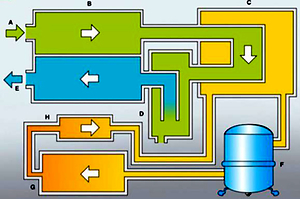PRACA ORYGINALNA
Adsorption dryer for use in railways
1
Sieć Badawcza Łukasiewicz - Poznański Instytut Technologiczny, Polska
Data nadesłania: 28-04-2022
Data ostatniej rewizji: 27-07-2022
Data akceptacji: 28-07-2022
Data publikacji online: 31-07-2022
Data publikacji: 29-08-2022
Autor do korespondencji
Kacper Matusiak
Sieć Badawcza Łukasiewicz - Poznański Instytut Technologiczny, Sieć Badawcza Łukasiewicz - Poznański Instytut Technologiczny, Estkowskiego 9, 61-755, Poznań, Polska
Sieć Badawcza Łukasiewicz - Poznański Instytut Technologiczny, Sieć Badawcza Łukasiewicz - Poznański Instytut Technologiczny, Estkowskiego 9, 61-755, Poznań, Polska
Rail Vehicles/Pojazdy Szynowe 2022,1-2,77-85
SŁOWA KLUCZOWE
DZIEDZINY
STRESZCZENIE
Pneumatic brake, which use compressed air as a working medium, is the main brake of rail vehicles. The equipment used in the braking system requires sufficiently clean, without water vapour medium to work properly. Removing water vapour from the air prevents condensation and ice formation during winter, which guarantees correct brake operation. For this purpose, adsorption dryers are used in the railways to ensure the required pressure dew point value.
This article includes an overview of available compressed air drying methods, the results of calculations and bench test of the dryer prototype developed at the Institute. Assumptions and requirements for the device intended for use in railways are based on European standards and UIC cards.
REFERENCJE (23)
2.
Atuonwu C., van Straten G., van Deventer H.C. et al. Improving adsorption dryer energy efficiency by simultaneous optimization and heat integration. Drying Technology. 2011, 29, 1459-1471. https://doi.org/10.1080/073739....
3.
Atuonwu C., van Straten G., van Deventer H.C. et al. Model-based energy efficiency optimization of a low-temperature adsorption dryer. Chemical Engineering Technology. 2011, 34(10), 1723-1732. https://doi.org/10.1002/ceat.2....
4.
Xu B., Zhang X., Zhang S. et al. Research on double tower dryer based on air brake system of rail vehicle. Journal of Physics: Conference Series. 2021, 1948, 012126. https://doi.org/10.1088/1742-6....
5.
Dajeni M., Bartels P.V., Sanders J.P.M. et al. Computational fluid dynamics for multistage adsorption dryer design. Drying Technology. 2008, 26(4), 487-502. https://doi.org/10.1080/073739....
6.
Goliwąs D. Uzdatnianie sprężonego powietrza w pojazdach trakcyjnych. Pojazdy Szynowe. 2007, 4, 31-43. https://doi.org/10.53502/RAIL-....
7.
Kang S.-W., Chang S.-H., Kim H.-J. et al. A study on operating method to save energy from the adsorption dryer in the process of purifying compressed air. Journal of Society of Korea Industrial and Systems Engineering. 2016, 39(3), 180-191. https://doi.org/10.11627/jkise....
8.
Code UIC 612-2. Specific sub-system requirements (traction, braking, etc.) for EMU/DMU, locomotives and driving coaches (Rolling stock sub-system requirements, requirements for economic purposes, requirements for railway standardisation), 2009.
9.
Kozlov V., Piskun E., Ilicheva O. Investigation of the processes of adsorbent regeneration by compression heat in an adsorption dryer of compressed air. Matec Web of Conferences. 2020, 324, 02009. https://doi.org/10.1051/matecc....
10.
Litchfield R.J., Liapis A.I. An adsorption-sublimation model for a freeze dryer. Chemical Engineering Science. 1979, 34(9), 1085-1090. https://doi.org/10.1016/0009-2....
12.
Polski Komitet Normalizacyjny PN-EN 50125-1 Kolejnictwo – Warunki środowiskowe stawiane urządzeniom – Część 1: Tabor i wyposażenie pokładowe. 2014.
13.
Polski Komitet Normalizacyjny PN-EN 60721-3-5 Klasyfikacja warunków środowiskowych Część 3-2: Klasyfikacja grup czynników środowiskowych i ich ostrości. Transport i przeładunek. 2018.
14.
Polski Komitet Normalizacyjny PN-EN 61373 Zastosowania kolejowe. Wyposażenie taboru kolejowego. Badania odporności na udary mechaniczne i wibracje. 2011.
15.
Ripol-Saragosi L. Compressed air mechanical drying for railway branch of Europe. Transport Problems. 2010, 5(4), .
16.
Ripol-Saragosi T., Ripol-Saragosi L. Compressed air drying process energy consumption decrease by intellectual management systems implement. International Multi-Conference on Industrial Engineering and Modern Technologies. 2019, 1-6. https://doi.org/10.20858/tp.20....
17.
Rusinski E., Czmochowski J., Smolnicki T. Zaawansowana metoda elementów skończonych w konstrukcjach nośnych. Oficyna Wydawnicza Politechniki Wrocławskiej. Wrocław 2000.
18.
Schaumann S.P. Air compressor systems for passenger rail applications. International Compressor Engineering Conference. 2008, 1918, 1-9. https://docs.lib.purdue.edu/ic....
19.
Sureshkannan V., Vijayan S., Lenin V.R. Design and performance analysis of compressed air adsorption dryer with heatless regeneration mode. Heat and Mass Transfer. 2022, 58, 631-641. https://doi.org/10.1007/s00231....
20.
Techniczna specyfikacja interoperacyjności odnosząca się do podsystemu „Tabor — lokomotywy i tabor pasażerski” systemu kolei w Unii Europejskiej nr 1302/2014. 2014.
21.
Tuch T.M., Haudek A., Muller T. et al. Design and performance of an automatic regenerating adsorption aerosol dryer for continuous operation at monitoring sites. Atmospheric Measurement Techniques, 2009, 2, 417-422. https://doi.org/10.5194/amt-2-....
23.
Zhang Y., Zhang Q.M., Wang R. et al. Safety analysis and fault automatic recognition technology of regenerative adsorption dryer. IOP Conference Series: Earth and Environmental Science. 2019, 237(3), 032058. https://doi.org/10.1088/1755-1....
Udostępnij
Przetwarzamy dane osobowe zbierane podczas odwiedzania serwisu. Realizacja funkcji pozyskiwania informacji o użytkownikach i ich zachowaniu odbywa się poprzez dobrowolnie wprowadzone w formularzach informacje oraz zapisywanie w urządzeniach końcowych plików cookies (tzw. ciasteczka). Dane, w tym pliki cookies, wykorzystywane są w celu realizacji usług, zapewnienia wygodnego korzystania ze strony oraz w celu monitorowania ruchu zgodnie z Polityką prywatności. Dane są także zbierane i przetwarzane przez narzędzie Google Analytics (więcej).
Możesz zmienić ustawienia cookies w swojej przeglądarce. Ograniczenie stosowania plików cookies w konfiguracji przeglądarki może wpłynąć na niektóre funkcjonalności dostępne na stronie.
Możesz zmienić ustawienia cookies w swojej przeglądarce. Ograniczenie stosowania plików cookies w konfiguracji przeglądarki może wpłynąć na niektóre funkcjonalności dostępne na stronie.



